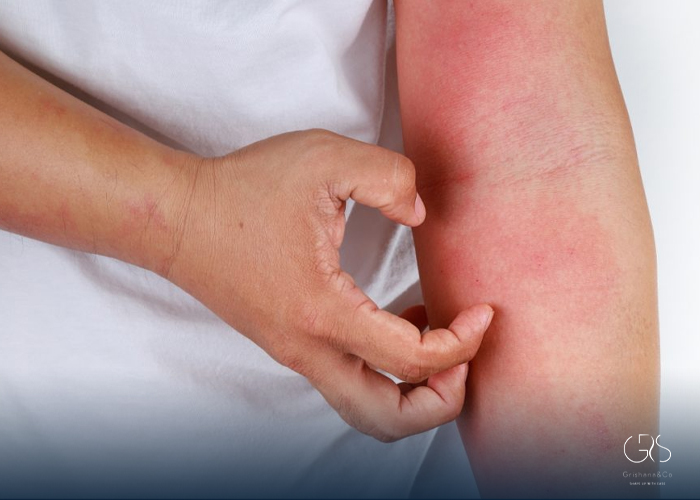Food allergies are an increasingly common health issue affecting both children and adults worldwide. A food allergy occurs when your immune system mistakenly identifies a specific protein in food as harmful. In response, it releases chemicals like histamine that cause various physical reactions — ranging from mild itching to severe, life-threatening conditions known as anaphylaxis.
According to the World Allergy Organization (WAO), nearly 10% of people globally have some form of food allergy. Understanding food allergies symptoms and treatment is vital because proper diagnosis and prevention can save lives and improve quality of life.
How the Immune System Causes Food Allergies
Your immune system is designed to protect you from harmful invaders like bacteria and viruses. However, in food allergies, it becomes overly sensitive. When you eat an allergenic food, your body releases Immunoglobulin E (IgE) antibodies that target the food protein. The next time you consume the same food, these antibodies trigger immune cells to release histamine and other chemicals, leading to symptoms.
This reaction is very different from food intolerance, which is caused by digestive issues or enzyme deficiencies, not immune activity. For instance, lactose intolerance results from a lack of lactase enzyme, not from an immune response. Recognizing this difference is essential when discussing food allergies symptoms and treatment.
Common Types of Food Allergies
There are hundreds of foods that can cause allergies, but about 90% of all reactions come from the “Big Eight” allergens:
Milk
Eggs
Peanuts
Tree nuts (almonds, walnuts, cashews, etc.)
Fish
Shellfish
Soy
Wheat
In many countries, sesame has now been added as a ninth major allergen. Let’s take a closer look at the most common ones.

Milk Allergy
Mostly seen in infants and young children, milk allergy often causes hives, vomiting, or digestive upset. Many children outgrow it by adolescence.
Peanut Allergy
One of the most severe and lifelong allergies. Even trace amounts of peanuts can trigger anaphylaxis. It’s one of the most studied in food allergies symptoms and treatment research.
Egg Allergy
Egg allergies commonly appear in childhood and may resolve over time. Reactions can range from skin irritation to respiratory issues.
Shellfish Allergy
Typically lifelong and more common in adults, this allergy includes shrimp, crab, and lobster. Reactions can be serious and unpredictable.
Tree Nut Allergy
Tree nuts such as walnuts and pistachios often cause severe, lifelong allergies. People with one nut allergy may react to others.
Symptoms of Food Allergies
The symptoms of a food allergy vary from person to person and may occur within minutes to a few hours after eating. Recognizing early signs is crucial for effective management and safety.
Mild to Moderate Symptoms
Itchy mouth or throat
Hives, eczema, or skin rash
Swelling of lips, face, or eyes
Nausea or stomach pain
Nasal congestion or sneezing
Severe Symptoms (Anaphylaxis)
Difficulty breathing or swallowing
Drop in blood pressure
Dizziness or fainting
Rapid or weak pulse
Loss of consciousness
Anaphylaxis is a medical emergency. The only first-line treatment is epinephrine, administered immediately via an auto-injector such as an EpiPen, followed by hospital care.
Understanding these warning signs is a key part of food allergies symptoms and treatment education for patients and caregivers.

Diagnosis of Food Allergies
Correct diagnosis helps prevent unnecessary restrictions and ensures safety. Allergists and immunologists use several tools to identify food allergies accurately:
Detailed Medical History – Reviewing past reactions, timing, and food intake.
Skin Prick Test – Small amounts of allergens are placed on the skin; reactions are observed for swelling or redness.
Blood Test (Specific IgE Test) – Measures levels of allergy-related antibodies in the blood.
Oral Food Challenge – The most reliable test, done under medical supervision to confirm or rule out a food allergy.
Combining these tests allows specialists to tailor a precise food allergies symptoms and treatment plan.
Effective Treatment Options
Although there’s no complete cure yet, several effective treatments and management strategies help reduce risk and control symptoms.
1. Avoidance of Allergenic Foods
Strict avoidance of allergenic foods is the foundation of food allergies symptoms and treatment. This includes careful label reading, learning alternative ingredients, and avoiding cross-contamination in restaurants or shared kitchens.
2. Emergency Medications
Antihistamines help relieve mild symptoms such as itching or hives.
Epinephrine (adrenaline) is essential for severe allergic reactions. Anyone with a history of anaphylaxis should always carry an EpiPen or similar device.
3. Oral Immunotherapy (OIT)
This emerging treatment involves gradually introducing small amounts of allergens under medical supervision to build tolerance. Studies show success especially for peanut, milk, and egg allergies. However, it must always be done under professional guidance.
4. Biologic Therapies
Medications such as omalizumab (Xolair) work by targeting IgE antibodies, preventing them from triggering allergic reactions. Research continues to expand this promising area of food allergies symptoms and treatment.
Preventing Food Allergies
While not all allergies are preventable, evidence shows certain early interventions can help lower risk.
Introduce Allergenic Foods Early
According to the LEAP (Learning Early About Peanut Allergy) study, introducing peanuts and eggs to infants around 4–6 months of age may significantly reduce allergy risk.
Support Gut Health
A healthy gut microbiome plays a major role in immune tolerance. Probiotics, high-fiber foods, and balanced diets may support allergy prevention.
Breastfeeding
Exclusive breastfeeding for at least the first 4–6 months of life may reduce the likelihood of developing allergic diseases.
Avoid Unnecessary Food Restrictions
Avoiding allergenic foods too early without medical guidance can increase risk rather than reduce it. Consult a pediatrician before removing foods from a child’s diet.
These evidence-based prevention strategies are often highlighted in modern research about food allergies symptoms and treatment.
Living with Food Allergies
Managing Allergies in Daily Life
Always read ingredient labels carefully.
Inform restaurant staff and friends about your allergies.
Keep emergency medication on hand at all times.
Wear a medical alert bracelet.
Keep your EpiPen within easy reach.
Coping and Emotional Wellbeing
Living with food allergies can be stressful, leading to social anxiety or fear of eating out. Support groups, counseling, and educational resources can help families build confidence in managing food allergies symptoms and treatment effectively.
Children and Food Allergies
Food allergies are especially concerning in children since they may not recognize symptoms early. Parents and caregivers should:
Teach children not to share food at school.
Inform teachers and daycare providers about the allergy.
Keep action plans and epinephrine available at school.
The good news: some children outgrow certain allergies (like milk or egg) as they age, though peanut and shellfish allergies often persist.

Food Allergy Myths and Facts
Myth 1: Food Allergies Are the Same as Intolerances
Fact: Food intolerances involve digestion; allergies involve the immune system.
Myth 2: Tiny Amounts of Allergen Are Safe
Fact: Even microscopic traces of allergens can trigger severe reactions.
Myth 3: Cooking Destroys Allergens
Fact: Some allergens (like milk) may reduce with heat, but most (like peanuts or shellfish) remain active.
Dispelling myths helps improve public understanding of food allergies symptoms and treatment.
Latest Advances in Allergy Research
Exciting new research is reshaping our understanding of allergies and their management:
Epicutaneous Immunotherapy (EPIT): Uses a skin patch to safely introduce allergens to the immune system.
Probiotic Therapy: Certain probiotics may help modulate immune responses and reduce allergic tendencies.
DNA and mRNA-Based Vaccines: Under study for long-term desensitization to food allergens.
Such innovations are paving the way for safer and more effective food allergies symptoms and treatment options in the near future.
When to See a Doctor
Consult an allergist or healthcare professional if you suspect a food allergy. Immediate medical care is necessary if you experience:
Difficulty breathing
Swelling of the face or throat
Dizziness or loss of consciousness
Prompt medical attention ensures proper diagnosis and management for food allergies symptoms and treatment tailored to your needs.
Conclusion
Food allergies can be frightening, but with awareness, education, and proper medical guidance, they can be safely managed. Recognizing food allergies symptoms and treatment helps individuals take proactive steps to avoid exposure and respond quickly during emergencies.
Ongoing research in immunotherapy and prevention continues to offer hope for millions worldwide living with food allergies.
Sources
- American Academy of Allergy, Asthma & Immunology (AAAAI), Food Allergy
- National Health Service (NHS UK), Food allergy
- Mayo Clinic, Food allergy
- National Institute of Allergy and Infectious Diseases (NIAID), Food Allergy










